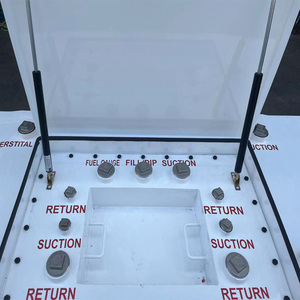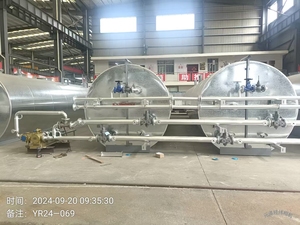
All categories
Featured selections
Trade Assurance
Buyer Central
Help Center
Get the app
Become a supplier

(5053 products available)
































Asphalt tanks are essential components of the paving machinery, designed to heat and store liquid asphalt. These tanks come in various types, each catering to specific needs and applications within the construction and road maintenance industries.
Direct Fire Asphalt Tanks
Direct fire asphalt tanks use open flame burners to heat the asphalt. The burners are situated directly beneath the tank. While these tanks are generally affordable and easy to operate, they come with significant drawbacks. Direct fire systems can create hot spots within the tank, leading to uneven heating and potential degradation of the asphalt. Furthermore, there is a risk of generating harmful emissions or even causing fires if not managed properly. Despite these challenges, direct fire asphalt tanks find utility in smaller-scale operations where cost-effectiveness and simplicity are prioritized.
Indirection Fire Asphalt Tanks
In contrast to direct fire tanks, indirect fire asphalt tanks employ a closed heating system. In this system, burners are located outside the tank, and the heat transfer occurs through a heat exchange medium (e.g., water or oil). This design prevents direct contact between the burners and the asphalt, resulting in more precise temperature control. Indirect fire asphalt tanks are particularly advantageous for large-scale projects or when high-quality asphalt is required, as they minimize the risk of hot spots and emissions.
Emulsified Asphalt Tanks
Emulsified asphalt tanks are specifically engineered to store and maintain emulsions, which are mixtures of asphalt, water, and additives. These tanks are equipped with systems that prevent the separation of components and ensure consistent quality. Emulsified asphalt is commonly used for surface treatments and seal coats, making these tanks crucial for applications where emulsions are essential.
Polymer-Modified Asphalt Tanks
Polymer-modified asphalt tanks are designed to accommodate asphalt blends modified with polymers to improve performance. These modifications enhance properties such as elasticity, durability, and resistance to deformation. Polymer-modified asphalt is frequently utilized in high-traffic areas and regions with extreme weather conditions, making these tanks vital for applications that demand superior pavement performance.
Mobile Asphalt Tanks
Mobile asphalt tanks are designed for portability and can be towed behind a vehicle or trailer. This mobility allows for on-site transportation and delivery of hot asphalt to various locations. Mobile tanks are particularly useful for small-scale projects, maintenance work, and instances where quick asphalt application is required.
Split Asphalt Tanks
Split asphalt tanks are equipped with multiple compartments, allowing the simultaneous storage of different asphalt grades or mixtures. This feature is beneficial for projects requiring varying asphalt specifications. Split tanks enable efficient management of multiple asphalt types, reducing the need for separate storage and transportation.
Different types of asphalt tanks have different specifications depending on their intended use. Generally, the specifications include the following:
Capacity
Asphalt storage tanks come in different capacities. The capacity of the tank determines the volume of asphalt it can hold. There are small tanks with a capacity of a few thousand liters. Larger tanks can have a capacity of up to 100,000 liters or more.
Heating System
Heating systems in asphalt tanks vary in design and efficiency depending on the tank type. Some common heating systems include indirect heating with steam coils, electric heaters, or hot oil circulation.
Insulation
Insulation is an important feature in an asphalt tank. Insulation helps maintain the internal temperature of the tank. The level of insulation is measured by the type of insulating material used and its thickness. Thick insulation minimizes heat loss, which improves energy efficiency.
Material
Asphalt tanks are manufactured from durable materials to ensure longevity. Common materials include steel and fiberglass. Steel tanks provide strength and resistance to corrosion. Fiberglass tanks are lightweight and resistant to chemical corrosion.
Safety Features
Asphalt tanks are designed with various safety features to minimize the risk of accidents. Common safety features include pressure relief valves, emergency shutdown systems, and fire suppression systems.
Access and Maintenance
Asphalt tanks are designed with features that facilitate easy access for maintenance. For instance, some tanks have manholes, access platforms, and inspection ports. Maintenance features also include removable insulation and access panels.
Asphalt tank maintenance is crucial for the proper functioning of the tank. Regular maintenance improves safety and minimizes environmental hazards. Here are some general asphalt tank maintenance requirements:
Choosing suitable asphalt tanks for sale is a challenging task, especially because the tanks are not so common. Here are some tips to help choose the right asphalt tank for the business:
Capacity
Consider the capacity of the tank. The tank should have a capacity that can handle the required volume of asphalt for specific projects. For smaller paving projects, a smaller tank with a capacity of about 5 tons is recommended. Larger and more extensive projects will require tanks that can hold more than 20 tons of asphalt.
Heating System
Consider the heating system of the tank. An efficient heating system is vital for maintaining the desired temperature of the asphalt. Look for tanks with high-capacity heaters to reduce heating time and evenly heat the material.
Insulation
Good insulation is crucial for an asphalt tank. The tank's insulation will minimize heat loss and maintain consistent product temperature. Look for tanks with thick insulation to ensure temperature stability and save on heating costs.
Mobility
Consider the mobility of the tank. If the tank is required on different job sites, a mobile and road-towable tank is ideal. Tanks with trailers, including axles and towing capabilities, offer greater mobility and convenience.
Quality and Durability
Quality and durability are key considerations when choosing an asphalt tank. Look for tanks made of high-quality materials, such as carbon steel, to withstand harsh conditions and asphalt's corrosive nature.
Safety Features
When choosing an asphalt tank, safety features should be a top priority. Look for tanks with safety valves, pressure gauges, and emergency shut-off systems to ensure safe operation. Additionally, consider tanks with protective barriers and access platforms for personnel safety.
Loading and Unloading
Consider the loading and unloading features of the tank. Tanks with efficient loading and unloading systems, such as pumps and hoses, will facilitate asphalt transfer and reduce downtime. Look for tanks with convenient access points and well-designed loading and unloading areas.
Maintenance and Serviceability
Consider the maintenance and serviceability of the tank. Choose tanks with easily accessible components for regular maintenance and repairs. Additionally, consider the availability of spare parts and the manufacturer's after-sales service to ensure prompt support and assistance.
Environmental Regulations
Asphalt tanks must comply with environmental regulations, including emissions and noise control. When choosing the tank, consider the environmental standards required in the area and select tanks with appropriate measures to minimize the environmental impact.
Asphalt tank replacement can be a daunting task, and many people may shy away from it due to the complexity and cost implication. However, it is possible to replace an asphalt tank both in a professional and DIY context.
When it comes to DIY, it is necessary to have the right skills, knowledge, and experience to replace the tank successfully. If not, it is advisable to seek professional help. It is also important to adhere to safety regulations and guidelines when replacing an asphalt tank. Here are some general steps to follow when replacing an asphalt tank.
Note: These DIY instructions are general and may vary depending on specific tank models and local regulations. Always refer to the manufacturer's instructions and consult with professionals if needed.
Q1: What are the safety concerns related to asphalt tanks?
A1: Due to the hot nature of the asphalt in the tanks, there are safety concerns. There are also health concerns because the asphalt contains fumes that can be hazardous if they are not controlled.
Q2: How are safety concerns controlled in asphalt tanks?
A2: The tanks are equipped with safety features such as fire extinguishers and safety training for workers. There are also safety protocols that are followed during the handling and transportation of the asphalt.
Q3: What environmental concerns are there with asphalt tanks?
A3: During the heating of asphalt, there is potential for emissions to be released into the environment. There is also the risk of spills or leaks that can contaminate the soil and water.
Q4: How are environmental concerns controlled in asphalt tanks?
A4: The environmental controls that are put in place include emissions monitoring and control. There are also spill prevention measures that are implemented to protect the environment from potential harm.